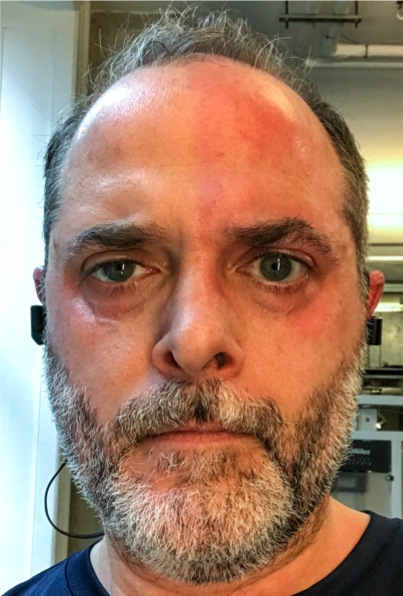Case Presentation: A 46 year-old man with a past medical history of untreated hypertension presented with right ptosis and miosis. The patient was in his usual state of health until one month prior to presentation, when he developed right retrobulbar pain in the absence of additional upper airway or constitutional symptoms. The patient subsequently noticed right eyelid droop and right periorbital swelling. During an aerobic exercise session, the patient noticed hyperemia and perspiration limited to the left half of his face; he took a self-portrait using his cellphone camera. The patient immediately presented to his primary medical doctor’s office, where his blood pressure was over 200/100 mmHg. He was referred to the Emergency Department. Physical exam revealed right eye ptosis and miosis, and the patient’s self-portrait confirmed anhidrosis, consistent with Horner syndrome. The patient’s blood pressure was 211/176 mmHg; physical and neurologic exams were otherwise normal. He has no family history of connective tissue disease. MRI and MRA of the brain, head, and neck revealed right internal carotid artery dissection without evidence of ischemia or infarction. He was admitted to the hospital. Blood pressure was controlled with oral anti-hypertensives. Aspirin therapy and high-intensity statin were initiated. The patient was discharged home with neurologic and vascular surgical follow-up appointments.
Discussion: Horner Syndrome is a manifestation of pathology involving brainstem, cervicothoracic spinal cord, lung apex, or vasculature of head and neck. Our patient’s self-portrait and physical exam confirmed Horner Syndrome. The absence of additional neurologic symptoms or exam abnormalities suggested a lesion affecting the postganglionic sympathetic nerves. These clinical findings were substantiated by the diagnosis of carotid artery dissection. Patients with carotid artery dissection with resultant Horner syndrome have a lower likelihood of stroke or bilateral dissection and a more favorable three-month outcome compared to those without Horner syndrome. Antithrombotic treatment is recommended for patients with carotid dissection for prevention of subsequent ischemic stroke; however, no statistically significant difference between antiplatelet and antithrombotic strategies has been determined. Antihypertensive treatment with a goal blood pressure under 140/90mm Hg and statin therapy are recommended for patients with atherosclerotic extracranial carotid disease. Patients experiencing recurrent ischemic events despite medical therapy, may warrant endovascular intervention or revascularization.
Conclusions: Horner Syndrome is a striking manifestation of dissection of the carotid artery, an uncommon sequela of uncontrolled hypertension. Despite the potentially life-threatening consequences of carotid dissection, conservative management with blood pressure control and anti-thrombotic therapy may achieve arterial intimal wall repair and resolution of symptoms.

.jpg)
